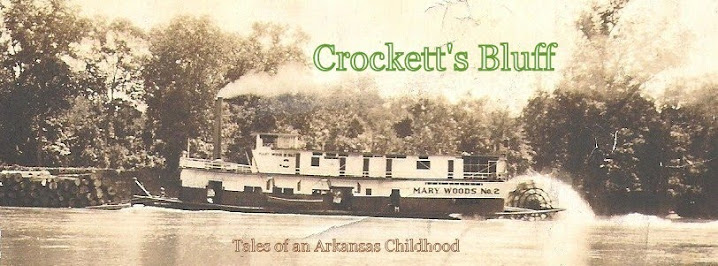Here are two childhood memories written for my grandson Griffin Bliss for a project related to Lois Lowry's novel The Giver in his seventh grade English class at St. Andrews School at Savannah, Georgia.
The first is about my first job at about his age plowing cotton for Mr. George Kline in his field out the Hill Road just west of Voss Lake. The second is a recollection of the recurrent thrill of all Bluff children at the sound of the whistle of the Mary Woods No. 2
About Your Age
When I was about your age, a sixth or seventh grader, I was
offered my first real paying job.
Something more than the familiar string of unpaid chores assigned to all
boys that age who lived on farms in rural Arkansas in the late 1940s.
It was a relatively simple job working on a small cotton
farm owned by Mr. George Kline, one of our neighbors in Crockett’s Bluff, a
small community at the bend of the White River where I was born and grew up.
The downside of this job was that I was required to be at
his house shortly after sunrise in the morning, not to return until the sun was
setting in the evening, a long day. But
the upside was that I was paid what was to me a hefty sum of $2.50 per day.
Since the field where we worked was almost two miles from
his house, we rode the horses back and forth each day we would be using in our
labors.
I was required simply
to stabilize a plow, pulled by a great buckskin horse appropriately named
“Buck,” up and down between the rows of cotton plants uprooting any grass or
weeds that might be there. Mr. Kline
came along behind me down these rows with another smaller and more precise plow
– pulled by his favorite horse “Lightning” -- that loosened the soil and “cultivated”
the plants in their early stages of growth.
Buck was an enormous so-called “draft”
horse, bred for hard and heavy work, and his strength appeared to me to be
unlimited. So, any thought that I, at
less than a hundred pounds, was supposed to control his starting, turning, and
stopping movements with the reins I leaned into from time to time tied behind
my back, was a joke. Consequently, Buck
stopped and turned whenever he pleased, much to my enormous frustration.
Consequently, since I never gave up trying to control him,
from time to time over those sweltering summer days I suffered the modest shame
and embarrassment of being gently chastised by Mr. Kline about the quality of
the language I addressed to poor old Buck.
It was a long summer and the work was hard and long and
generally hot. But it was work of the
sort one got paid for, and I spent the first twelve dollars I earned on a used
red bike with characteristic balloon tires at the Western Auto Store in DeWitt,
the county seat of Arkansas County Arkansas.
As I rode it for
miles over the graveled roads leading in and out of Crockett’s Bluff I felt
–what with a paying job – a new sense of what I would now call liberation.
*********
 |
| The image of an unknown photographer from a Woodiel family album and title image for this site. |
The
Mary Woods No. 2
The photograph of the
paddle-wheel steamboat pictured above was made from the bank of the White River
no more than two hundred yards or so from where I was born in Crockett’s
Bluff, Arkansas, a village in the 1930s
much smaller and even more “quiet” and “tired” than the Macomb that Harper Lee
describes in To Kill a Mockingbird.
So, when the steam-whistle of the Mary Woods No. 2 was
sounded, everyone, particularly children, dropped everything and headed for the
bluff banks overlooking the river.
Its sound could be
heard long before its barge of logs nosed slowly around the bend beneath the
red clay bluffs for which the village was named. We knew we were in for a treat, something truly
awesome to us. She was majestic: grand
and powerful enough to move upstream a barge stacked with logs larger than
anyone ever viewed elsewhere. And she
made all the noise necessary to justify her presence, the sound of her engines,
the splashing patter of her enormous rear wheel, and the
usual additional whistle as a special treat to us from the pilot on the bridge
who always returned our waves.
The experience was necessarily brief, since even though she
moved slowly when compared with the familiar out-board powered fishing boats, a
full view was limited to a panoramic minute or two, so it was necessary to run
barefoot down along the bank for the next clear opening with a view.
Then, when she was gone from view and rounding the next bend
near the familiar sandbar, her super gigantic waves having reached the shore
making the house boats bounce like buoys, we were left with the image above,
the Mary Woods with the steam from its twin stacks streaming along its back
downstream as it forged upriver its massive barge of freshly cut timber.
A scene that is in memory almost as alive now as it was then
– a lingering sensual feast in the midst of an otherwise long, slow and quiet summer day in a “tired” little
hamlet at the bend of the White River.
 |
| At the viewing site with my sister Maureen Shireman. |
